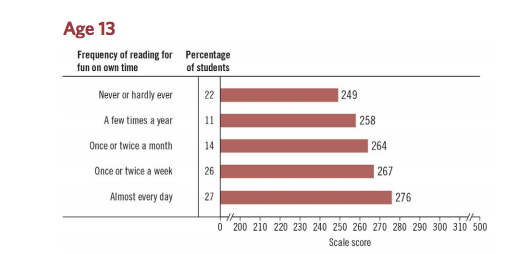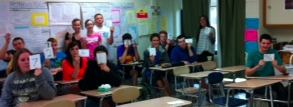How challenging is it for a teacher to run an independent reading program? Very challenging. That is the only thing thing that Newsweek reporter Alexander Nazaryan got right in his NYTimes op-ed piece The Fallacy of ‘Balanced Literacy’ (7/6/14).
His lack of success in having students choose their own reading for pleasure over the course of one school year, should not grant him the opportunity to decry the practice. His own failure to encourage students to engage in reading for pleasure should not dissuade other teachers from encouraging students to develop life-long reading habits. Had he the proper training and resources in balanced literacy, he would have witnessed how the challenge of implementing independent reading in a classroom can be met at any grade level and is a critical step to making students life-long readers.
If he had the training, he would recognize that teachers who are familiar with books for specific age groups and levels of interest can make reading recommendations to students or help facilitate highly successful peer to peer book recommendations. If he had the resources of high interest, low-level texts in jam packed classroom libraries for his students, he would have increased the level of engagement. If he had utilized the time for reading to individually confer briefly with students about their reading while other students read quietly, he would have established a classroom routine that would allow him to informally measure student growth as they read. Finally, if he had impressed upon students the importance of reading for pleasure, he would have helped their academic success in all other classes.
Research studies (compiled by the American Library Association) have determined that reading outside of the classroom is the best predictor for student success:
The amount of free reading done outside of school has consistently been found to relate to achievement in vocabulary, reading comprehension, verbal fluency, and general information. Students’ reading achievement correlates with success in school and the amount of independent reading they do (Anderson, Wilson, and Fielding 1988; Guthrie and Greaney 1991; Krashen 1993; Cunningham and Stanovich 1991; Stanovich and Cunningham 1993).
This research from the ALA is borne out by testing through The National Assessment of Educational Progress (NAEP) test, which has monitored the academic performance of 9-, 13-, and 17-year-old students since the 1970s. Long-term trend assessments in reading are measured on a scale of 500 points. In taking the NAEP, students volunteered information on their reading habits. The results from this data in 2012 demonstrated that the average score for the 22% of those students aged 13 who never (or hardly ever) read independently was 25 points lower than students who read every day. By age 17, the difference had increased to 30 points.
This data confirms what we have witnessed in our own classrooms. Our students are given SSR (silent sustained reading) time in class for independent reading in grades 7-12. Independent reading for our school means that students get to choose what they would like to read without having to take a quiz or a test on the book. The only “requirements” are that students keep a running record (we are using Shelfari) of their independent reading books. We ask them to share their recommendations with their peers. We talk to them about what they read.
Sometimes students are offered a choice from a length list of thematically connected books, and sometimes the choice must be in a particular genre (non-fiction, memoir, world literature). Other times, the choice is entirely open and students can read whatever books they want. Our block schedule allows us the luxury of offering students 15-20 minutes each period. A quick estimate means that over the course of the school year (40 weeks), meeting twice weekly (roughly 30 minutes minimum a week), students will be offered a minimum of 20 hours of reading time in class. They make very good use of that time.
The main goal of our independent reading program is to encourage students to read beyond the walls of the classroom; our 15 minutes spent in class is intended as a “hook” to connect students with books that they might want to read or as a “refresher” to reconnect a book already being read.
Encouraging students to read independently means practice, and the time we provide in class contributes to that reading practice. At the end of this year, we are celebrating the number of books read over the course of the year by taking group photos of students proudly holding up the number of books they have read independently over the past school year. So, rather than read a confessed failure in an op-ed piece that incorrectly characterizes independent reading written by someone who has left education, take a look at how the challenge of independent reading is being successfully met in our classrooms. The proof is in the pictures.











I read the editorial a fews days ago and had similar feelings of unease. A successful independent reading program takes serious department-wide commitment, not just a one-year attempt by a first-year teacher. Your school seems the standard-bearer–you should be proud.
Bravo! Thank you for pointing out that Mr. Nazaryan’s piece is in fact a confession of his shortcomings. Implementing balanced literacy is a challenge and requires a strong knowledge base, a knowledge base that teachers have to build through wide reading of both professional texts and the books, both fiction and nonfiction, that our students will be reading.
Thanks for the post, as for all your posts. When you use Shelfari, do you ask kids to post reviews and comments there? Was there a factor that led you to prefer Shelfari over Goodreads?
Hello!
We use Shelfari because of the “ridiculously simplified synopsis” and quotes pages…but mostly because we started with Shelfari…and saw no reason to change. Kids can keep the account going, and we have a valuable history of their reading.
Sometimes we have them post lengthy reviews OR answer specific questions that connect to what we are reading in class (“Odysseus makes several bad decisions; what bad decisions does a character in the book you are reading make?”) or general questions (“How important is friendship in your book?”).
Mostly, we have them add what they read to their book shelves…and make recommendations. Sometimes we ask them to comment on a book a friend is reading.
We can organize students into groups on the Shelfari platform as well.
I hope that explains what we are doing…
Thank you for taking the time to read the post!
I just read Nazaryan’s article and it’s no wonder SSR failed in his classroom. I teach high school in NB, Canada and SSR is something I have embraced wholeheartedly. Over the past six years I have amassed a classroom library of about 1000 titles including memoirs, graphic novels, classics and everything in between. Despite the fact that my high school has a pretty good library, my classroom is used by students who I don’t teach. Why? Because I talk to them about the books; I recommend books based on their interests and abilities; I encourage them to read outside their comfort zones. I really think that encouraging a life-long love of reading (one that extends well beyond the walls of a classroom) is the greatest gift I can give my students. And they know it.
Thanks for posting your thoughts on this subject. We’re on the same page. 🙂
Great post. SSR is a great practice for any year level. I have heard it referred to as USSR (uninterrupted silent sustained reading) and DEAR (drop everything and read). It not only shows that reading is valued, it gives students time to engage with material that is of interest to them, not just set for instructional purposes. It makes an enormous contribution to their development as independent and life-long readers!
Hi,
I have nominated you for The Very Inspirational Blogger Award as I enjoy reading what you have to say about education. You have a lot to inspire other teachers and their students.
You can check out the post in which I made the nomination here: http://wp.me/p3O5Jj-iM
If you wish to pay the compliment forward, go to this post for the rules of participation: http://wp.me/p3O5Jj-hI
Best wishes,
Norah
WOW! What a wonderful compliment. Thank you so much! I am in Boise visiting with my 82 yr. old mother, hence the delay in response…please know that your nomination is certainly appreciated.
I did poke around on your blog a little. I particularly liked your flash fiction responses (March)…(when do you find the time???
I also noticed that this month is your blog anniversary…you have shared a great deal of information on this one-year-old!
Thank you again for taking the time to nominate me and share my blog link in your post. I will “pay this forward!”
Lovely! I look forward to seeing whom you nominate! 🙂
Thank you, thank you, thank you! I am going to print this out and hand keep it on hand for every time I am questioned as to why the kids in my class are “reading and not learning.”
Thanks, Tara.
There are other pictures (7th & 8th grade) but I didn’t upload them. The timing of that NYTimes article and the end of school was so unfair…like a cheap shot. He (Alexander Nazaryan) got to defame the best things literacy teachers do (provide choice, conference, journal writing) while teachers were out of school….he probably thought some of would not notice. Most of us are exhausted those first weeks of July! Anyway, glad to read that you enjoyed my photos…I call them my “Penny Kittle” moments!
Well, thanks again, Vicki! I get a “Vinton Bounce” every time you mention me…my stats were up all month! If stats were all I cared about, that would make me happy, but I am more than happy that you have included me in your own posts. I feel honored, validated, and just a little unnerved…need to keep reading on their minds in this noisy world (…in their “distracted globes”) so my teachers and I can continue to be braggin’.
Thanks, again…I appreciate being included in your post.